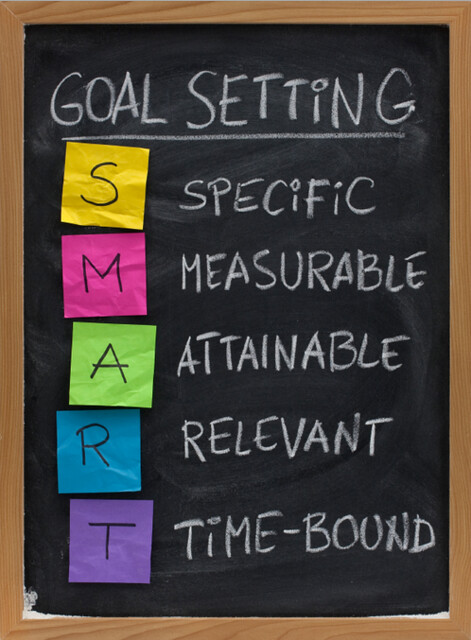Introduction to SMART Goals
SMART goals are specific, measurable, achievable, results-focused and time-bound objectives that help you make progress towards either completing or reaching a bigger goal. These specific objectives are attainable, because they are realistic. They also require planning and organization. The SMART acronym stands for:
- Specific: Clearly defined, distinct, and well-stated
- Measurable: Quantifiable and able to be tracked (time, money, etc.)
- Attainable: Realistic and achievable within reason
- Results-focused: Directly address and improve the desired outcome/result
- Time-bound: Have a deadline or timeline attached to the goal
Steps for Setting SMART Goals
The first step for setting SMART goals is to define what the final result looks like. This will depend on the type of goal you are setting, but it is important to be as specific as possible. Your goal should provide a clear direction for you to move in and it should also be measurable and achievable.
- Define the desired result
- Set specific goals and milestones that will help you reach it
- Identify any obstacles that could prevent you from reaching the goal
- Clearly outline the steps necessary to move forward
- Create a timeline with a specific deadline
Arranging your SMART Goal
Once you have established the goal, you should break it down into smaller pieces and lay them out in an organized way. This will help you create a plan of action and ensure that you stay on track. Here are some steps to help you do this:
- Set priorities: Determine which goals and tasks are most important
- Create a timeline: Set a timeline and deadline for each task, to keep yourself accountable
- Create specific milestones: Measureable steps that keep you on track and let you track your progress
- Set smaller goals: Break down your goal into smaller pieces so that you remain focused and motivated
- Create an action plan: Make sure that each task is well defined and list out the steps you will need to take to reach it.
Measuring and Tracking your SMART Goals
Tracking your progress on your SMART goal is an important part of keeping you motivated and on track. You should keep track of each task and the timeline for completion so you can stay on schedule. You should also evaluate your progress on a regular basis to help identify any potential issues or delays. Here are some tips for measuring and tracking your SMART goals:
- Set up automated reminders and calendar alerts: Keep yourself on track by setting reminders.
- Track your progress: Measure and track your progress against the timeline and goals.
- Use analytics and goal-tracking tools: Utilize technology to help you track your progress.
- Don’t forget to reward yourself: Celebrate your successes and use them to stay motivated.
Conclusion
Setting and tracking SMART goals is an important part of achieving success. By following the steps outlined above, you can ensure that you are setting realistic goals and achieve them. Following the SMART goal setting guidelines can be beneficial for both short-term and long-term objectives, and help you stay on track and motivated to meet your goals.
Next Steps for Understanding SMART Goals
To further understand how to set SMART goals and ensure that you meet them requires practice. After reading this article, it is recommended to practice making SMART goals and tracking them. Think of a short-term goal that you want to accomplish in the next month or two, and create a plan that includes setting SMART goals. This can be done by first setting a timeline and then breaking the goal down into more manageable goals through the SMART goal-setting process. Additionally, connect with professionals that have experience setting and achieving SMART goals and ask them for advice.
Resources
- Time Management Ninja: SMART Goals Explained
- Yast: A Comprehensive Guide For Smarter Goal Setting
- MindTools: How to Set SMART Goals

How can you set SMART goals give example?
SMART Goal Components: Specific: I want to read at least one book per month instead of watching TV, Measurable: I’ve joined a book club where we set weekly reading goals, Achievable: I enjoy reading and learning but have just gotten away from it lately, Relevant: By reading, I’ll learn more about my industry , enhance my writing skills and become a better leader, Time Oriented: I’ll read for my book club for 1 hour every Tuesday evening for the next 12 weeks.
How do you set goals and meet them?
Set your goals and make them happen | Action for Happiness Decide. Think of something you want to do or work towards, Write it down. Carefully, Tell someone. Telling someone we know about our goals also seems to increase the likelihood that we will stick at them, Break your goal down. This is especially important for big goals, Plan your first step, Keep going, Celebrate And reflect. When we successfully achieve a goal, it is important to take stock of how far we have come, and to celebrate progress, no matter how small.
How would you ensure that you set a smart goal?
Tips for setting SMART goals Specific. You have a much greater chance of accomplishing a specific goal than a general goal, Measurable. Establish concrete criteria for measuring progress toward the goal you set, Action oriented. Break down goals into actionable objectives to keep from becoming overwhelmed, Realistic, Timely . Establish a sense of urgency and set deadlines for achieving your goals.
What are the benefits of setting SMART goals?
1. Increased motivation: When goals are SMART, individuals are more likely to be motivated to achieve them. This is because each SMART goal has specific and measurable criteria that can be checked off as they are achieved.
2. Improved focus and productivity: By setting specific goals, individuals have the ability to more easily focus their efforts and be more productive.
3. Greater accountability: SMART goals can act as a kind of contract between an individual and their team, employer, or mentor. Having clear expectations helps hold individuals accountable to their goals and encourages them to strive to reach them.
4. Easier goal setting: SMART goals make goal setting easier by serving as a framework, which can be used to quickly and efficiently develop measurable objectives and objectives.
5. Time-management: By breaking down goals into smaller, measurable pieces, SMART goals enable individuals to better manage their time and allocate resources appropriately.
What are the five components of SMART goals?
1. Specific: Goals should be clear and unambiguous, so that they can be easily understood and tracked.
2. Measurable: Goals should be set up with plans that include milestones and target measures, so that progress can be monitored.
3. Achievable: Goals should be realistic and specific, and take account of realistically achievable outcomes.
4. Relevant: Goals should be relevant to business and organizational objectives – they should not be arbitrary.
5. Time-bound: Goals should have a specific timeline, with clear start and end dates. This helps ensure that goals are completed on time.
What are examples of SMART goals?
1. Increase online sales revenue by 10% in the next six months.
2. Increase the number of daily active users on the website by 15% over the next six months.
3. Increase customer satisfaction ratings by 8% in the next year.
4. Reduce customer churn by 15% within the next two quarters.
5. Launch a new product within five months.
6. Increase the number of subscribers by 5% in the next three months.
7. Optimize product pages for improved search engine rankings within one month.
8. Generate 10 new leads for the sales team within two weeks.
9. Expand international presence by entering three new markets within six months.
10. Reduce customer service wait times by 25% in the next quarter.
What should be included in a SMART goal?
A SMART goal should include a specific, measurable, attainable, relevant, and time-bound element. This means that the goal should be specific and clearly states what needs to be achieved, measurable and able to be tracked, attainable and realistic given the current circumstances, relevant to the larger goal, and have a set timeline for completion.
What examples of SMART goals can be used?
1. Increase website sign-ups by 10% by the end of the quarter.
2. Reduce customer service response time to no more than 30 minutes within the next 2 months.
3. Increase blog followers by 25% in the next 6 months.
4. Double employee productivity in the next 3 months.
5. Increase customer satisfaction scores by 15% within the next year.
6. Achieve an 80% customer retention rate in the next quarter.
7. Increase sales by 20% in the next quarter.
8. Reach 400 online followers by the end of the year.
9. Achieve a 10% reduction in marketing costs by the end of the year.
10. Increase customer loyalty by 30% within the next 6 months.
What are the benefits of setting SMART goals?
1. Clear and precise: SMART goals are clear, specific, and easily understood by everyone in the team. This ensures that everyone involved in the task is on the same page and there is no confusion or misinterpretation of the goal.
2. Measurable: SMART goals can be easily monitored and measured. This allows you to track progress and identify areas that need more focus or adaption.
3. Achievable: SMART goals are designed with realistic achievement in mind. This makes it possible to focus energy and resources in the most effective way while still pushing the boundaries of what’s possible.
4. Relevant: SMART goals are focused on the organizations current needs and priorities. This ensures that efforts are not wasted in pursuits that are unimportant or unnecessary for the task at hand.
5. Time-bound: SMART goals come with a timeline for completion. This encourages greater efficiency and discipline, and ensures that the team stays motivated and on track.
What are the components of SMART goals?
The SMART acronym stands for Specific, Measurable, Achievable, Relevant, and Timely.
Specific: Set a clearly defined, detailed goal.
Measurable: Establish concrete criteria for measuring progress toward the attainment of each goal you set.
Achievable:The goal should be realistic and attainable — it should stretch your abilities but remain possible.
Relevant: The goal needs to matter to you; make sure it aligns with other relevant goals in your life.
Timely: Set yourself a realistic timeframe in which to achieve the goal.

